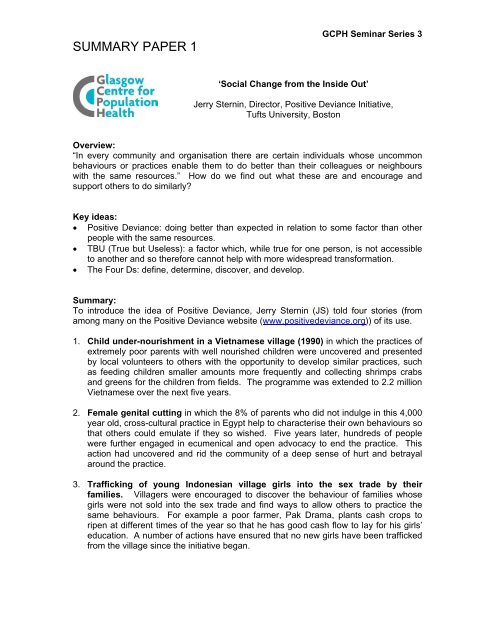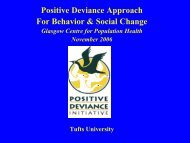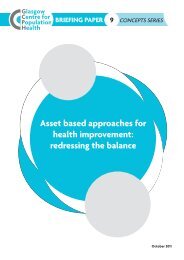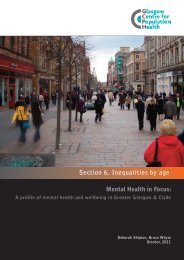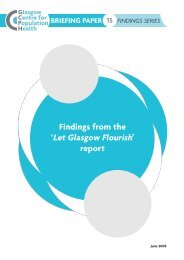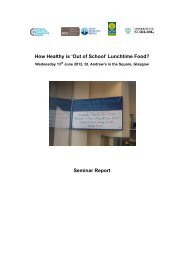Lecture summary - Glasgow Centre for Population Health
Lecture summary - Glasgow Centre for Population Health
Lecture summary - Glasgow Centre for Population Health
You also want an ePaper? Increase the reach of your titles
YUMPU automatically turns print PDFs into web optimized ePapers that Google loves.
SUMMARY PAPER 1<br />
GCPH Seminar Series 3<br />
‘Social Change from the Inside Out’<br />
Jerry Sternin, Director, Positive Deviance Initiative,<br />
Tufts University, Boston<br />
Overview:<br />
“In every community and organisation there are certain individuals whose uncommon<br />
behaviours or practices enable them to do better than their colleagues or neighbours<br />
with the same resources.” How do we find out what these are and encourage and<br />
support others to do similarly?<br />
Key ideas:<br />
• Positive Deviance: doing better than expected in relation to some factor than other<br />
people with the same resources.<br />
• TBU (True but Useless): a factor which, while true <strong>for</strong> one person, is not accessible<br />
to another and so there<strong>for</strong>e cannot help with more widespread trans<strong>for</strong>mation.<br />
• The Four Ds: define, determine, discover, and develop.<br />
Summary:<br />
To introduce the idea of Positive Deviance, Jerry Sternin (JS) told four stories (from<br />
among many on the Positive Deviance website (www.positivedeviance.org)) of its use.<br />
1. Child under-nourishment in a Vietnamese village (1990) in which the practices of<br />
extremely poor parents with well nourished children were uncovered and presented<br />
by local volunteers to others with the opportunity to develop similar practices, such<br />
as feeding children smaller amounts more frequently and collecting shrimps crabs<br />
and greens <strong>for</strong> the children from fields. The programme was extended to 2.2 million<br />
Vietnamese over the next five years.<br />
2. Female genital cutting in which the 8% of parents who did not indulge in this 4,000<br />
year old, cross-cultural practice in Egypt help to characterise their own behaviours so<br />
that others could emulate if they so wished. Five years later, hundreds of people<br />
were further engaged in ecumenical and open advocacy to end the practice. This<br />
action had uncovered and rid the community of a deep sense of hurt and betrayal<br />
around the practice.<br />
3. Trafficking of young Indonesian village girls into the sex trade by their<br />
families. Villagers were encouraged to discover the behaviour of families whose<br />
girls were not sold into the sex trade and find ways to allow others to practice the<br />
same behaviours. For example a poor farmer, Pak Drama, plants cash crops to<br />
ripen at different times of the year so that he has good cash flow to lay <strong>for</strong> his girls’<br />
education. A number of actions have ensured that no new girls have been trafficked<br />
from the village since the initiative began.
SUMMARY PAPER 1<br />
GCPH Seminar Series 3<br />
4. MRSA in United States Hospitals. MRSA causes approximately 100,000 deaths in<br />
the US every year. Working in a veterans’ hospital in Pittsburgh, the PD approach<br />
was introduced to discover new ways to hinder its transmission based on the<br />
practice of all staff in the hospital.<br />
Following these four stories, JS presented a <strong>summary</strong> of the concepts underpinning<br />
Positive Deviance.<br />
• Uncommon practices exist “be<strong>for</strong>e our eyes” in every community or organisation.<br />
These practices help some do well with the same resources as others who do not.<br />
• A Positive Deviance Enquiry enables the community to discover the practices of<br />
Positive Deviants.<br />
• Only those practices accessible to all are kept: the rest are deemed “True but<br />
Useless” (<strong>for</strong> example “when I fall on hard times my rich uncle helps me out”) and<br />
are discarded, as not everyone can adopt them.<br />
• It is easier and more effective to act into a new way of thinking than think into a new<br />
way of acting.<br />
• The presence of positive deviants implies that it is possible to improve things today<br />
without waiting <strong>for</strong> all of the underlying causes to be tackled (although JS<br />
emphasised that underlying systemic factors need to be addressed too).<br />
The four Ds of Positive Deviance are:<br />
• Define the problem, and the desired outcome (a behaviour or status change) clearly<br />
and succinctly. It has to be observable and measurable.<br />
• Determine if anybody (individual, organisation, etc) exhibits the desired behaviour or<br />
status.<br />
• Discover, through PD enquiry, what strategies these people adopt to find better<br />
solutions than their counterparts.<br />
• Develop and implement opportunities <strong>for</strong> others to PRACTICE these behaviours.<br />
Each step is carried out by the community of interest itself, allowing PD solutions to<br />
emerge from understanding existing replicable aspects of solutions, rather than working<br />
in a predetermined codified way from problem to solution. The uncovering of existing<br />
solutions practiced by those “just like me” creates a climate where other solutions can<br />
emerge. It is the practice that is of interest, not the person per se.<br />
The most important elements of this relationship between knowing and doing are:<br />
• Self discovery of and by individuals, communities, teams, etc.<br />
• Social proof based on what is known and seen to work. This acts as a catalyst to<br />
change.<br />
• Opportunities to identify and practice these solutions <strong>for</strong> oneself and not simply being<br />
told what to do or how to do it by others.
SUMMARY PAPER 1<br />
GCPH Seminar Series 3<br />
Positive Deviance works well when:<br />
• adaptive behavioural and social change rather than technical challenges exist;<br />
• an intractable problem is worth the risk of a new approach;<br />
• Positive Deviants exist; and<br />
• leaders and skilled facilitators are willing to champion the ef<strong>for</strong>t, and to create the<br />
space <strong>for</strong> Positive Deviance Enquiry.<br />
The approach also raises some challenges. It requires a professional shift from outside<br />
‘expert help’ to ‘facilitator’, com<strong>for</strong>t with uncertainty and lack of control over outcomes. It<br />
tends to be intensive in terms of time and human resources. This in turn raises<br />
important questions about the scalability of the technique. These issues are<br />
surmountable with an approach that is patient and considered with the promise to yield<br />
significant results.<br />
The views expressed in this paper are those of the speaker and do not necessarily reflect the views of the<br />
<strong>Glasgow</strong> <strong>Centre</strong> <strong>for</strong> <strong>Population</strong> <strong>Health</strong>.<br />
Summary prepared by the <strong>Glasgow</strong> <strong>Centre</strong> <strong>for</strong> <strong>Population</strong> <strong>Health</strong>.


